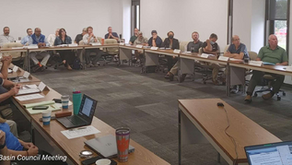Improved Collaboration: Some Group Work is Better Suited for Individuals
- JD Solomon
- Nov 9, 2023
- 3 min read

Not all work is best suited for teams. The next time your group work is failing, forget about developing an intervention. Ask yourself first whether the group work should be individual work. Our intentions may be good, but the context may be wrong. These are a few thoughts on improving collaboration by not trying to facilitate a group effort.
Organizations Like Working in Teams
+ Increased Task Performance
Organizations expect a higher quality and quantity of work from teams than from individuals working on their own. Call it synergy.
+ Greater Creativity
Teams are resources for cross-fertilization of ideas, especially for complex problems.
+ Improved Organizational Learning
Organizations expect individuals to pass along what they learned on one team to their next team. By doing so, the organization is gaining depth and breadth.
+ Higher Employee Engagement
Collaboration is normally thought to help grow the organization's bonds, increase job satisfaction, and minimize turnover.
The Trouble with Traditional Organizational Approaches
The main trouble with traditional organizational approaches is that they essentially aim at overarching results. Environmental contexts and specific process needs are ignored. In many cases, this default approach leaves facilitators mitigating issues on day one. All problems do not require a team.
Three Things Essential for Effective Facilitation
Effective facilitation and team collaboration require three things that produce interactive active communication:
1. Appropriate context
Context helps team members understand the relevance and importance of the information being conveyed. For example, it is difficult to communicate on a multi-dimensional, complex problem if a recent job site accident is consuming the thoughts of a group.
Facilitators have the least control over external factors that impact the collaboration context.
2. Compatible Knowledge
Cross-functional teams bring different knowledge and experience. Facilitators use specific structures and techniques to develop compatible knowledge across the group.
3. Open Feedback Channels
Interactive communication that produces collaboration requires formal and informal feedback channels. Great facilitators “do whatever it takes” to establish and maintain those feedback channels.
“Although necessary for interactive communication, creating teams with compatible knowledge and open feedback channels takes time and resources.”
When to Use Individual Work
Individual work in these three circumstances:
A. Autonomy
Some tasks or projects are best suited for individual work when autonomy is essential. These tasks may require a single person's decision-making and responsibility.
B. Time Constraints
When there's a tight deadline or an urgent task, working individually can be more efficient, as it reduces coordination and communication time.
C. Specific Expertise
If a task requires specialized knowledge or skills that only one person possesses, it might be more effective for that individual to work independently.
When to Use Group Work
A. Complex Projects
Teams are often more effective when dealing with complex projects that require diverse skills and expertise. Collaborative efforts can lead to innovative solutions and better problem-solving.
B. Synergy
When the combined efforts of a team can produce better results than the sum of individual efforts, teamwork is generally preferred. This is often referred to as synergy.
C. Learning and Development
Teamwork can be valuable for individual and collective learning. Team members can learn from each other and develop new skills.
Case Example
I found myself cast into the role of outside facilitator for an infrastructure master plan that had come off the rails. In seeking interventions to re-unify the team and get the project back on schedule, I noticed that every activity had a sub-activity and a sub-team. One example was demand projections, which were quickly assigned to one person with a charge to bring everything back to the team.
While much could have been gained from multi-dimensional input and the camaraderie it would inspire, the work could easily be done as individual work. The end result was that we got buy-in, saved time, and pulled the team back together with a focus on efficiency.
Creating Great Collaboration
Not all work is group work. Great facilitators survey the context to determine the resources needed to produce interactive communication. In some cases, the synergy, creativity, learning, and engagement are worth it. In other cases, effective collaboration requires an individual to get the task done. Do whatever it takes!




Comments